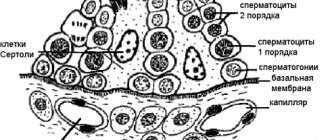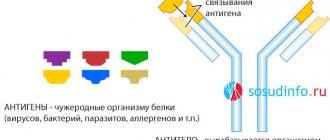Antibodies to Epstein-Barr virus capsid antigen IgG, EBV VCA IgG
Antibodies to capsid antigen EBV VCA IgG
- a marker of early and late primary infection. The Epstein-Barr virus is a group 4 herpes virus that infects human B lymphocytes, causing infectious mononucleosis.
In addition, it is associated with the development of hairy leukoplakia, nasopharyngeal carcinoma, Burkitt's lymphoma, Hodgkin's disease, and B-cell lymphoma. Primary infection often occurs with moderate tonsillitis and pharyngitis or is asymptomatic.
Clinical manifestations of infectious mononucleosis are detected in 35–50% of infected people. The incubation period of the disease is 4–6 weeks. In the initial period of the disease, the infection manifests itself as muscle pain, fatigue, and general malaise. Then they are joined by fever, sore throat, enlarged lymph nodes, spleen and sometimes liver. In some cases, a rash appears on the arms and torso. Symptoms last 2–4 weeks.
The Epstein-Barr virus is safe for pregnant women and the fetus. In infants and young children, mononucleosis rarely develops. Anti ebv igm vca - part of a bacterium or virus by which cells of the immune system recognize this object as foreign, called an antigen (epitope).
EBV VCA IgG
Antibodies of the IgM class to the capsid antigenic complex of the Epstein-Barr virus are characteristic of the early period of infection and later. They appear in the early phase of the disease and disappear within 4–6 weeks from the onset of acute primary infection. This type of antibody is also detected during reactivation (resumption of the course) of the infection. Negative results for IgG antibodies to Epstein-Barr with symptoms that are characteristic of infectious mononucleosis indicate a different etiology of the disease.
A positive result confirms that the patient was once infected, recovered from the disease and is now an asymptomatic carrier. In essence, these antibodies act as memory cells, similar to those formed after an infection or vaccination. If an increased amount of antibodies is detected, this indicates reactivation of the infection.
Indications:
- laboratory confirmation of the diagnosis for clinical suspicion of acute infectious mononucleosis;
- assessment of the stage of current infection;
- diagnosis of lymphoproliferative and oncological diseases associated with the Epstein-Barr virus.
Preparation
It is recommended to donate blood in the morning, between 8 am and 12 pm. Blood is drawn on an empty stomach, after 4–6 hours of fasting. It is allowed to drink water without gas and sugar. On the eve of the examination, food overload should be avoided.
Interpretation of results
Units of measurement: UE*
A positive result will be accompanied by an additional comment indicating the sample positivity rate (SP*):
- CP >= 11.0 – positive;
- CP <= 9.0 – negative;
- CP 9.0–11.0 is doubtful.
Positive result:
- acute infection with Epstein-Barr virus;
- chronic active infection with Epstein-Barr virus.
A positive result confirms that the patient was once infected, recovered from the disease and is now an asymptomatic carrier.
In essence, these antibodies act as memory cells, similar to those formed after an infection or vaccination. If an increased amount of antibodies is detected, this indicates reactivation of the infection. Negative result:
- no infection;
- early and late periods of post-infection;
- atypical primary infection or reactivation.
*Positivity rate (PR) is the ratio of the optical density of a patient's sample to the threshold value. CP - positivity coefficient, is a universal indicator used in enzyme immunoassays. CP characterizes the degree of positivity of the test sample and can be useful to the doctor for the correct interpretation of the result obtained. Since the positivity rate does not correlate linearly with the concentration of antibodies in the sample, it is not recommended to use CP for dynamic monitoring of patients, including monitoring the effectiveness of treatment.
Epstein Barr Virus capsid protein (VCA), IgG
IgG antibodies to the infectious mononucleosis virus (Epstein Barr Virus, EBV) are specific antiviral immunoglobulin proteins produced by the immune system in response to infection with the infectious mononucleosis virus and indicating a current or past infection.
Synonyms Russian
IgG class antibodies to the capsid protein of the Epstein Barr Virus (EBV), class G immunoglobulins to the capsid protein of the Epstein Barr virus.
English synonyms
Anti-Epstein-Barr viral capsid antigens IgG, Epstein Barr Virus (EBV), VCA-IgG, Anti-EBV (VCA) IgG, EBV-IgG anti-VCA.
Research method
Chemiluminescent immunoassay.
What biomaterial can be used for research?
Venous blood.
How to properly prepare for research?
Do not smoke for 30 minutes before the test.
General information about the study
Epstein–Barr virus is a widespread virus of the Herpesviridae family that primarily infects B lymphocytes, as well as T lymphocytes and epithelial cells. It is transmitted by airborne droplets. The peak incidence occurs at 15-25 years of age.
The first contact of a person with the virus occurs, as a rule, in childhood and leads to the development of a latent asymptomatic or low-symptomatic infection. In adults, the Epstein-Barr virus causes infectious mononucleosis, which in most patients is accompanied by fever, intoxication, enlarged lymph nodes, palatine and pharyngeal tonsils. The liver and spleen often become enlarged, and petechiae appear on the mucous membrane of the upper palate. Infectious mononucleosis can be complicated by splenic rupture, as well as hepatitis, pancreatitis, pneumonia, hemolytic anemia, thrombocytopenia, aplastic anemia, myocarditis, Guillain-Barre syndrome, encephalitis, meningitis.
The virus persists in small quantities in memory B cells. About 90% of adults are virus carriers. The persistence of the virus in B lymphocytes and epithelial cells continues throughout life, so that when immunity is reduced (for example, with HIV or immunosuppressive therapy after organ transplantation), reactivation of the infection can occur, which contributes to the development of lymphoproliferative diseases (including Burkitt's lymphoma), nasopharyngeal carcinoma or (most often) infectious mononucleosis.
In response to infection, the immune system produces various specific antiviral antibodies. In the acute stage of infection, IgM to the capsid protein (VCA) of the virus is the first to be detected in the blood, which reaches its maximum concentration in the blood plasma at the 3rd week of the disease and disappears by the 4-6th week. Later, IgG to the capsid protein appears, reaching a maximum at 2-4 weeks of the disease, then their concentration decreases, but they still persist for life. When the infection is reactivated, the titers of these antibodies usually increase. Antibodies to early antigens are detected at the acute stage of infection and disappear 3-6 months after the onset of the disease, but in 20% of infected people they can be detected for several years. Antibodies to the viral nuclear antigen (EBNA) are usually not detected at the acute stage of infection, appear in the blood no earlier than the 6-8th week of the disease (usually 2-4 months after the onset of the first symptoms) and persist throughout life.
Thus, an antibody test allows not only to detect an infection caused by the Epstein-Barr virus, but also to determine its stage.
What is the research used for?
- To confirm current or past infectious mononucleosis.
- To assess susceptibility to infection caused by the Epstein-Barr virus (infectious mononucleosis).
When is the study scheduled?
- In cases where existing clinical (fatigue, fever, sore throat, enlarged perimaxillary and cervical lymph nodes, enlarged liver and/or spleen) and laboratory (atypical lymphocytes in peripheral blood) signs indicate current or past infectious mononucleosis.
- For flu symptoms in pregnant women (along with tests for cytomegalovirus infection, toxoplasmosis, etc.).
- If the patient (even without symptoms of infection) was in close contact with a patient with infectious mononucleosis - to assess the strength of the immune system and susceptibility to infection.
What do the results mean?
Reference values
Result: negative.
Signal/cutoff ratio: 0 - 0.9.
Reasons for the positive result:
- the presence of active immunity due to a previous infection (along with the detection of antibodies to nuclear antigen (EBNA) and the absence of IgM to the capsid antigen (VCA) of the Epstein-Barr virus);
- current or recent infectious mononucleosis (in combination with detection of IgM to capsid antigen (VCA) and antibodies to early antigens (EA-D) of the Epstein-Barr virus);
- Epstein–Barr virus reactivation.
Reasons for negative results:
- absence of infection caused by the Epstein-Barr virus (IgM to the capsid antigen (VCA) of the Epstein-Barr virus is not detected); if there is a suspicion of infection, it is advisable to repeat the IgG determination after 2-4 weeks;
- early stages of infectious mononucleosis (provided that an increase in the level of IgM to the capsid antigen (VCA) of the Epstein-Barr virus is detected) - repeat the study over time after 14 days;
- low levels of Epstein-Barr virus in the blood;
- absence of an immune response or a weak immune response to the Epstein-Barr virus due to disorders in the immune system (IgM to the capsid antigen (VCA) of the Epstein-Barr virus is not detected).
An increase in antibody titer over time (in paired sera) rather indicates an acute infection or reactivation of an infection, while a decrease indicates a recently resolved infection. The amount of antibodies in the blood does not reflect the severity or duration of the infection. In some cases, high levels of IgG to the capsid protein (VCA) of the Epstein-Barr virus can persist throughout life.
Also recommended
- Epstein Barr Virus capsid protein (VCA), IgM
- Epstein Barr Virus, DNA [real-time PCR]
- Epstein Barr Virus early antigens (EA), IgG
- Epstein Barr Virus nuclear antigen (EBNA), IgG (quantitative)
- Complete blood count (without leukocyte formula and ESR)
- Alanine aminotransferase (ALT)
- Aspartate aminotransferase (AST)
- HIV 1, 2 Ag/Ab Combo (determination of antibodies to HIV types 1 and 2 and p24 antigen)
Who orders the study?
Infectious disease specialist, pediatrician, ENT, hematologist, therapist, general practitioner.
Literature
- Cohen JI Epstein-Barr virus infection / JI Cohen // N. Engl. J. Med. – 2000. – Vol. 343, N 7. – P. 481–492.
- Hess RD Routine Epstein-Barr virus diagnostics from the laboratory perspective: still challenging after 35 years / RD Hess // J. Clin. Microbiol. – 2004. – Vol. 42, N 8. – P. 3381–3387.
- Isakov V.A. Herpes: pathogenesis and laboratory diagnosis: a guide for doctors / V.A. Isakov, V.V. Borisova, D.V. Isakov. – St. Petersburg: Lan Publishing House, 1999. – 192 p.
- Johannsen EC, Schooley RT, Kaye KM Epstein-Barr Virus (Infectious Mononucleosis). In: Principles and practice of infectious disease / GL Mandell, Bennett JE, Dolin R (Eds) ; 6th ed. – Churchill Livingstone, Philadelphia, PA 2005. – 2701 p.
- Tselix A. Epstein-Barr virus / A. Tselix, Jenson H.V. – NY: Taylor & Fransis, 2006. – 410 p.
Antibodies to Epstein-Barr virus nuclear antigen IgG, EBV EBNA IgG
Antibodies to Epstein-Barr virus nuclear antigen IgG, EBV EBNA IgG
- allows you to determine the presence of IgG antibodies, which indicate a past or chronic infection caused by the Epstein-Barr virus. The Epstein-Barr virus is a group 4 herpes virus that infects human B lymphocytes, causing infectious mononucleosis. In addition, it is associated with the development of hairy leukoplakia, nasopharyngeal carcinoma, Burkitt's lymphoma, Hodgkin's disease, and B-cell lymphoma.
Primary infection often occurs with moderate tonsillitis and pharyngitis or is asymptomatic. Clinical manifestations of infectious mononucleosis are detected in 35–50% of infected people.
The incubation period of the disease is 4–6 weeks. In the initial period of the disease, the infection manifests itself as muscle pain, fatigue, and general malaise. Then they are joined by fever, sore throat, enlarged lymph nodes, spleen and sometimes liver. In some cases, a rash appears on the arms and torso. Symptoms last 2–4 weeks.
The Epstein-Barr virus is safe for pregnant women and the fetus. In infants and young children, mononucleosis rarely develops.
IgG antibodies to nuclear antigen (EBNA)
IgG antibodies to nuclear antigen (EBNA) in the Epstein-Barr virus test indicate a previous infection with the Epstein-Barr virus. Antibodies to the Epstein-Barr Virus Nuclear Antigen of the IgG class are detected in the blood 4–6 months after the onset of infection. IgG-EBNA antibodies in the Epstein-Barr virus test are detected late after infection and can be detected for life. The concentration of antibodies increases during the recovery period. The absence of antibodies to this antigen when antibodies to the capsid protein of the Epstein-Barr virus (anti-VCA IgM) are detected most likely indicates a current infection.
Indications:
- for the diagnosis of infectious mononucleosis;
- for differential diagnosis of diseases whose symptoms are similar to infectious mononucleosis;
- to detect exacerbation of chronic infection caused by the Epstein-Barr virus;
- for monitoring certain cancers (Burkitt's lymphoma, nasopharyngeal carcinoma) associated with the Epstein-Barr virus.
Preparation
It is recommended to donate blood in the morning, between 8 am and 12 pm. Blood is drawn on an empty stomach, after 4–6 hours of fasting. It is allowed to drink water without gas and sugar. On the eve of the examination, food overload should be avoided.
Interpretation of results
Units of measurement: UE*
A positive result will be accompanied by an additional comment indicating the sample positivity rate (SP*):
- CP >= 11.0 – positive;
- CP <= 9.0 – negative;
- CP 9.0–11.0 is doubtful.
Positive result:
- infection with the Epstein-Barr virus (detection of antibodies at a later date);
- transition to a chronic form of the disease or a period of reactivation of the infection.
Negative result:
- there was no Epstein-Barr virus infection;
- early stages of infection (low antibody titer).
*Positivity rate (PR) is the ratio of the optical density of a patient's sample to the threshold value. CP - positivity coefficient, is a universal indicator used in enzyme immunoassays. CP characterizes the degree of positivity of the test sample and can be useful to the doctor for the correct interpretation of the result obtained. Since the positivity rate does not correlate linearly with the concentration of antibodies in the sample, it is not recommended to use CP for dynamic monitoring of patients, including monitoring the effectiveness of treatment.






